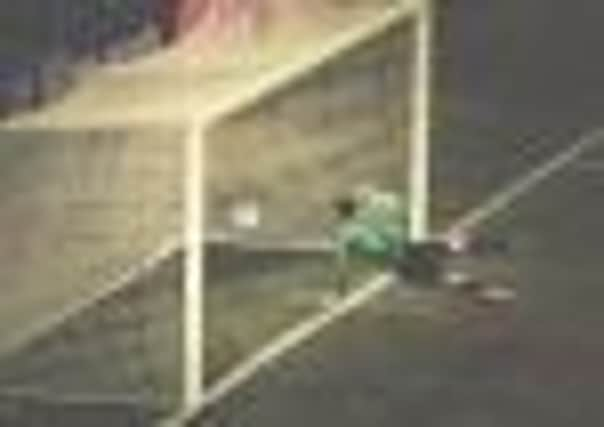Waiting game for goalline technology


After years of foot-dragging, football’s lawmakers approved “optional not obligatory” technology in principle and although the first system could be in place in FIFA competitions by the end of this year – and definitely by the 2013 Confederations Cup and the 2014 World Cup – it will take a while longer to be implemented by Europe’s leagues and clubs.
At its annual meeting, the International FA Board (IFAB) approved final tests on two systems: British company Hawk-Eye – widely used already in cricket and tennis – and GoalRef, a German-Danish firm – ahead of an ultimate decision the day after the end of the European Championship in July. Six other systems were ruled out after a series of experiments by scientists in Switzerland.
Advertisement
Hide AdAdvertisement
Hide AdFIFA president Sepp Blatter has been a reluctant convert to technology ever since the international outcry over Frank Lampard’s disallowed goal, in the 2010 World Cup second round tie for England against Germany. UEFA president Michel Platini is firmly opposed, as is Germany’s Franz Beckenbauer who heads FIFA’s Task Force on ways of improving the game. Platini favours the system of two extra goal-line assistants, used in all major European international competitions.
There is now a serious chance of both systems ending up operating side by side in what is surely a case of overkill. Optionality, as English FA general secretary Alex Horne put it. But while FIFA ideally plans to employ goalline technology for the Club World Cup in Japan in December, Scottish FA chief executive Stewart Regan said the SPL were likely to wait, along with the English Premier League, until the 2013-14 season – but only if the price was right.
Two instances of goals not being given in the SPL this season, despite TV replays clearly showing ball had crossed the line, have both gone Celtic’s way. In December, Rangers’ Lee Wallace’s seventh-minute header crossed the line but was over-ruled in their 1-0 defeat in the Old Firm fixture. Last month, during their 4-0 defeat, Hearts’ Stephen Elliot headed the ball over the line with the game goalless but again it wasn’t given.
“Next season is probably too soon and the costs are unknown,” said Regan. “I think, over time, technology will advance and prices ultimately will come down and there will come a point at which the SPL can enter this market. There is a demand for goal-line technology in the SPL and once the companies have passed the tests we would certainly be keen to try it.”
Hawk-Eye is a camera-based system while GoalRef uses a magnetic field around the goal with a special ball to identify a goal situation.
The final phase of testing will take place between now and June to make sure each system is robust enough to remain accurate in a match situation and, when implemented, a signal can be sent to the official within a second of the ball crossing the line. Like Regan, Horne doubted whether an approved system could be imported into the Premier League in time for next season.
“I would doubt it. You would need to wait until July for the decision, then go through procurement and installation of equipment for 20 clubs. That would not be a one-day job.”
The ultra-conservative IFAB, comprising FIFA and the four home associations, rarely if ever reverses previous decisions. But they had a change of heart when making an exception by lifting the ban on the Islamic headscarf being worn, pending final ratification by a health and safety working group.
Advertisement
Hide AdAdvertisement
Hide AdFIFA’s youngest and most progressive executive committee member Prince Ali of Jordan had led the campaign to overturn the ban on the hijab on safety grounds and gave a persuasive demonstration on new Velcro-designed headscarves deemed 100 per cent safe.
It was a significant victory for Prince Ali, who had been supported by a bullish social media campaign and even the United Nations, not only for Islamic women players worldwide but also in terms of his own status as FIFA’s latest vice-president. The issue first arose in a junior league in Canada and came to a head following a number of controversies involving Muslim women teams. Last year Iran were prevented from playing their 2012 Olympic second round qualifying match against Jordan because they refused to remove their hijabs before kick-off. Iran had topped their group in the first round of Olympic qualifiers but were handed 3-0 defeats as a penalty, ending their dreams of qualifying for the London Games.
Prince Ali’s case rested on a belief that a change of attitude would empower many more women to play football in the Islamic world. “I am deeply grateful that the proposal to allow women to wear a headscarf in football was unanimously endorsed by all members of IFAB,” he said after yesterday’s hearing. “I am confident that once the final ratification in the July Special Meeting of IFAB takes place, we will see many delighted and happy players returning to the football field and playing the game that they love.”
Approval was also granted to the English FA’s proposal to have a two-year experiment on rolling substitutes in amateur football. A recommendation to allow a fourth substitute to be used during extra-time was thrown out but lawmakers did agree that players red-carded for denying a goalscoring opportunity should not necessarily be suspended.